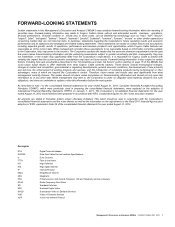Cogeco 2012 Annual Report Download - page 10
Download and view the complete annual report
Please find page 10 of the 2012 Cogeco annual report below. You can navigate through the pages in the report by either clicking on the pages listed below, or by using the keyword search tool below to find specific information within the annual report.Management’s Discussion and Analysis (MD&A) COGECO CABLE INC. 2012 9
CABLE SERVICES NETWORKS AND INFRASTRUCTURE
Cogeco Cable provides its Television, HSI, Telephony and Business solutions services through state-of-the-art fibre optic and two-way
broadband distribution networks. It is Cogeco Cable’s general policy to fully own its distribution networks and head-ends as well as its
transmission equipment and access facilities. As at August 31, 2012, Digital Television, VOD and Telephony services were available to
approximately 99%, 97% and 94% of homes passed, respectively, and approximately 97% of homes passed were served by a two-way cable
plant.
Cogeco Cable’s inter-city optical fibre network extends for a distance of over 10,000 kilometres. This includes over 110,000 kilometres of
optical fibre. Cogeco Cable has deployed optical fibre to nodes serving clusters of typically 500 or less homes passed, with multiple fibres per
node in most cases, which allows Cogeco Cable to rapidly extend the capacity of the fibre plant to clusters of 250 homes or less if and when
necessary. This process, known as “Node Splitting”, leads to further improvement in the quality and reliability while increasing the capacity of
two-way services such as HSI, VOD and Telephony.
Cogeco Cable currently uses under DOCSIS standards within its IP platform. DOCSIS has numerous advanced features, including the
prioritization of packets to ensure a continuous transmission and quality of service delivery. This prioritization is important for services that need
to be transmitted in real time, such as those of the Telephony service. The DOCSIS 3.0 standard is currently available to 83% of homes
passed served by Cogeco Cable two-way cable plant. This technology provides a flexible and expandable platform to further increase IP
transmission speeds up to 160 Mbps and beyond and for providing other products like symmetrical services, which are particularly well suited
for commercial customer applications.
Cogeco Cable has implemented an infrastructure with 550 MHz and 750 MHz capacity, depending on the cable system and customer needs.
The infrastructure with 550 MHz capacity allows for the transmission of up to 80 analogue channels and the 750 MHz infrastructure allows for
the transmission of up to 110 analogue channels. For reference purposes, each analogue channel (representing 6 MHz of bandwidth), with the
current compression, multiplexing and modulation technologies used by Cogeco Cable, allows for the transmission of up to 15 SD digital
television signals, or up to 3 HD signals.
In order to increase the bandwidth capacity of its cable systems, Cogeco Cable completed during the last fiscal year the first phase of its
program to convert into digital signals the remaining analog channels in its systems. Cogeco Cable deployed DTAs to its customers having
analog television equipment. DTAs convert Digital Television signals to analogue signals in the viewer’s home through a device installed on the
television set. The first phase of the program allowed Cogeco Cable to recover an average of 30 analogue channels per system in Ontario and
an average of 20 analogue channels per system in Québec. The second phase of this project, which will allow the recovery of the remaining
analogue bandwidth, is expected to be completed over the next three years.
Cogeco Cable also deployed the SDV technology in its systems to further increase bandwidth capacity. SDV technology allows Cogeco Cable
to selectively broadcast only the Digital Television channels that are currently being viewed by customers, effectively allowing Cogeco Cable to
offer a greater selection of digital channels, and is used particularly for low viewership content and channels. SDV technology currently serves
61% of homes passed served by a two-way cable plant.
Cogeco Cable is deploying the FTTH technology in new residential subdivision developments which meet specific criteria of size, proximity to
the existing plant and service penetration rate. The FTTH topology selected is RFoG. The primary benefit of RFoG is the ability to leverage
existing Cable Modem Termination Systems (“CMTS”), cable modem investments and back-office systems, all while maintaining service
continuity with existing video, VoIP, and preparing for higher speed Internet services.
ENTERPRISE SERVICES NETWORKS AND INFRASTRUCTURE
Cogeco Cable’s subsidiary, Cogeco Data Services Inc. ("CDS"), operates a 2,250 kilometre fibre optic network that extends throughout the
Greater Toronto Area and the Greater Montreal Area. The multiple facilities based infrastructure (Ethernet, Dense Wave Division Multiplexing
and Multiprotocol Label Switching (“MPLS”)) connects well over 1,000 commercial buildings within these two areas and enables high
bandwidth services.
CDS currently has three data centre facilities in Toronto and a small facility in Vancouver. These facilities have state of the art 24/7/365
monitoring, power redundancy, support, biometrics and onsite security providing a protected controlled environment for the provision of hosting
and colocation services. CDS opened a new phase of its data centre facility in downtown Toronto in the summer of 2012 targeting customers
that require close proximity to Toronto’s business and financial district. CDS also has two data centre facilities west of the city’s business
district for customers requiring facilities in close proximity to Toronto and a small facility in Vancouver for customers requiring access to the
west coast. In addition, CDS is building out a facility north of Toronto scheduled for commercial availability in the summer of 2013. It also
recently announced its plan to create a large data hosting facility in Montréal, scheduled to open in the Spring of 2014.
CDS has introduced a new suite of managed IT services, including server, operating system, application and network management that allow
its customers to outsource certain IT functions. These services are provided on customer-owned equipment hosted in CDS’ secure data centre
facilities. In addition, CDS provides its customers with compute, backup and storage services on its dedicated and shared infrastructure.
CDS' connectivity services are delivered via its all-optical standards-based networks in Toronto and Montreal. These networks provide CDS
with the capacity and flexibility to provide its customers with managed connectivity services that can easily scale as their business grows.
These services include managed wavelengths, Metro Ethernet and MPLS services that enable organizations to connect to their offices, data
centres and suppliers and run their applications across multiple locations.























